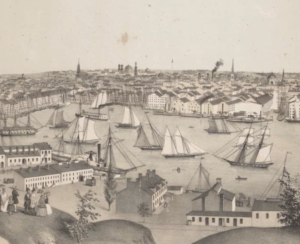Baltimore, a hub of early maritime activity
A perpetual boomtown from the Revolutionary War through the Civil War, Baltimore was a hotbed of industry and innovations that made it the fastest growing city in the United States. Its shipyards built the fastest ships, known as “Baltimore Clippers”, that helped win the War of 1812. These yards were famous the world over and attracted business for ship construction and repairs.
A perpetual boomtown from the Revolutionary War through the Civil War, Baltimore was a hotbed of industry and innovations that made it the fastest growing city in the United States. Its shipyards built the fastest ships, known as “Baltimore Clippers”, that helped win the War of 1812. These yards were famous the world over and attracted business for ship construction and repairs.
The story of Baltimore’s free Black ship caulkers is one of excellence in the face of adversity. In the years before the Civil War, before Black people were considered citizens and systematic racism afforded few (if any) rights, these free Black ship caulkers built a community that promoted education, community, and a trade that allowed for steady wages.
Fell’s Point’s Black ship caulkers were critical to the shipbuilding industry, ensuring that the ships were water-tight as they traveled to the farthest reaches of the world. The caulking process sealed gaps between the planks of a ship, by filling joints or gaps with oakum (loosely twisted fibers made by unraveling old ropes) using irons and caulking mallets and sealing the joints with pitch (pine tar).
From roughly 1838-1858 Black caulkers held a virtual monopoly on the caulking trade in Baltimore. This achievement provided them with opportunities unavailable to most Black people in pre-Civil War America. These skilled laborers formed their own trade association, negotiating wages with shipbuilders and restricting hiring to its association members only. The association formed its own beneficial society, which provided financial assistance to members if they became ill or injured.
Though the City’s Black ship caulkers earned less than white workers in any of the shipbuilding trades, their wages greatly exceeded the average Black Baltimorean. In 1860, caulkers owned an average $182 in personal property, while other free Blacks averaged $17-worth of personal property.

